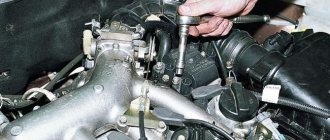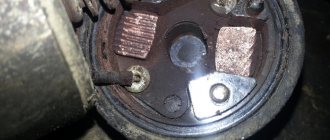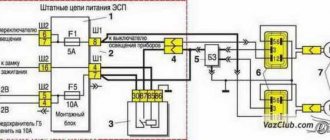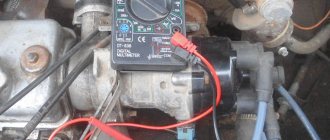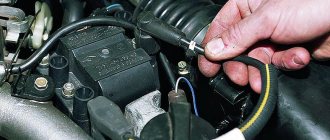Hi all. It was like this. I was driving and suddenly stalled, checked there was no spark. They brought him home and started treating him.
I checked the module with a multimeter and everything is fine. I checked the voltage on the chip from the ECU to the 12 volt module with the ignition on. And on the distribution wires when cranking there is 0 volt. The crankshaft sensor was changed, all the wiring was fine and the fuses were fine. The relays are all working. I even changed the ECU.
There was one moment. I checked the spark directly from the battery. I threw a wire onto the module. A spark struck. I checked the car and it started. But not for long and that’s it again. No spark. I also changed the pulley. Any thoughts?
- A hot VAZ 2110 stalls – 5 answers
- Engine speed does not rise above 3500 VAZ 2110 – 4 answers
- There is no spark in the ignition system when starting the VAZ 110 engine - 3 answers
- The engine does not run smoothly VAZ 2110 - 3 answers
- Three, shooting VAZ 2110 – 3 answers
As I understand it, everything fits together on the ignition module. If the MZ does not produce a spark, it means either it is faulty or there is something wrong with its connection. Check the wire connection block and the wires themselves again, especially at the bends (where the wire inside the braid breaks).
You need to check using a diagnostic scanner whether the ECU sees engine speed when trying to start it, i.e. check whether the crankshaft sensor is working correctly. And it's worth checking the voltage at the fuses.
How can you check the MH with a multimeter and conclude that everything is normal with it? ))))
Is there 12 volts on the MZ when the ignition is turned on relative to what, ground (body, terminal) or was the minus taken from the MZ connector?
“And on the distribution wires when scrolling, 0 volts” There, the pulse duration may be too short for your multimeter to measure it. The oscilloscope rules, at worst an LED with resistance.
When you turn the key, does the fuel pump operate as usual or is there something unusual? Is the immobilizer active or disabled? Is there an injection? Are the spark plugs wet after cranking? Does the check light come on when you turn on the ignition?
Many car enthusiasts have encountered the loss of spark on the 16-valve VAZ-2112 engine. What is this defect associated with? The first thing that suggests itself is the ignition. But, in this case, not everything is so simple, since the problem may lie deeper than it seems at first glance.
The video describes a situation when you lose a spark on the road and the car does not start:
The 16-valve VAZ-2110 has no spark
Candles are the first stage of testing. A visual inspection will help find flaws, after which they resort to checking the gaps and measuring the resistance.
Proven method: unscrew the spark plug, put on a high-voltage wire, install the base on the engine or body. After cranking the starter, a spark should form. Safety regulations must be followed.
Another reason may be hidden in the timing belt, namely, if the valve timing has gone astray due to improper installation of the timing disk. It is located on the crankshaft pulley and acts as a synchronizer.
It is quite possible to correct the situation if you change the installation of disks in accordance with the applied marks. The easiest way to find shortcomings is in working with high-voltage wires. However, it is necessary to understand that the engine will operate in strong vibration mode.
What could be the reason:
- The wire doesn't work. A complete replacement helps.
- Incorrect connection. Change the connection location.
There are many reasons that can cause a car to stop working.
Diagnostics using ODB-2 scanner
Since there are quite a few reasons for the lack of a spark, it is first recommended to carry out a comprehensive diagnosis of the car. A quick way to do this is to use an ODBII scanner.
Scan Tool Pro Black Edition
The main feature of Scan Tool Pro is the diagnosis of not only the engine, but also other components of the car (gearbox, abs, transmission, air conditioning system, etc.). The device works with all models of the domestic automobile industry (since 1993 for gasoline cars and 1996 for diesel cars) and was created specifically for the CIS market - it shows error codes with their interpretation in Russian. The scanner also displays the operation of all available sensors in real time, the vehicle’s VIN, its actual mileage and much more.
The engine won't start?
If, as a result of the check, it became clear that the spark hits the spark plugs, but the VAZ 2110 injector engine still does not start, then it is also necessary to diagnose it. The faults that cause this problem can be serious or not very serious.
At the same time, it is sometimes possible to cope with their solution without anyone’s help:
- It is necessary to purchase a spark gap and a Hall Sensor, which is inexpensive, but has an irreplaceable purpose. With their help, you can find out about the presence of a spark in the candles;
- Check the spark plugs to see if they are OK. A spark gap can be used for this purpose. However, you need to remember that the controller will be broken if candles are placed on its body;
- Perform fuel pump diagnostics. When you try to start a VAZ 2110 car, a characteristic sound will appear from under the rear seat. If there is no sound, then you need to check the fuses and the main relay. In a VAZ 2110 car they are located behind the side cover of the driver's seat.
If, after diagnostics, problems were identified with one of these elements, then you can fix them yourself. Usually the spark plugs begin to work after proper wiping, although this does not always happen, so they have to be replaced.
Common mistakes during diagnostics
Most people, due to ignorance of the VAZ 2110 injector machine, make many mistakes in the process of identifying problems.
Let's look at some of them:
- Many people make a common mistake: when they see that there is no spark, they want to check it for breaks. For this purpose, they place the wire close to the ground of the machine. But when performing such actions, the ignition module may break, so under no circumstances should you do this;
- Another problem is checking the spark discharge. If you place spark plugs on the engine body, a large induction current may appear. This occurs even due to slight contact of the spark plug with the ground, as a result of which the controller can also be damaged. Therefore, it is necessary to use a spark gap that will not allow the distribution of ignition with the same supply of high voltage to two spark plugs at once.
Causes
There may not be many reasons for the VAZ 2110 engine tripping, but it will be difficult for a beginner to find the fault. Here are some possible causes of a failing cylinder.
- Candles;
- Ignition module;
- Wires;
- Air leak;
- Injector not working;
- ECU;
- valves;
- Piston group;
Let's look at each of the reasons in detail.
Candles
The most likely problem is the spark plugs. Quite often, spark plugs fail, thereby disabling one of the car’s cylinders, or even more. This is due to low-quality fuel at our gas stations. It is recommended to change spark plugs every 30-40 thousand km. You can read how to do this here.
Ignition module
In the VAZ 2110, the ignition module is responsible for the formation of a spark. This is a large coil that produces a spark for every 4 cylinders in pairs of 1-3 and 2-4 cylinders. If the coil is faulty, then two cylinders will not work at once, and not just one.
It is worth noting that the cost of this element is very expensive, around 2000 rubles, to make sure that it is broken, it is best to ask a neighbor for a known good module and install it on your car in order to exclude other causes.
Wires
High-voltage wires conduct the spark from the module to the spark plug. They must have strong insulation and the slightest crack in their insulation leads to a spark breaking through to the body, which will lead to the car shaking. Driving with bad wires can damage the ignition module.
Air leak
It often happens that over time, rubber products and gaskets on VAZ internal combustion engines fail under the influence of high temperatures; they lose their elasticity and begin to leak air. Air leaks, which can affect the combustion of the internal combustion engine, are located on the sealing rings of the injectors and on the corrugations of the receiver or its rings. You can read how to check a car for air leaks in our article.
Injectors
The nozzle is one of the important parts of the car injector; it supplies a portion of fuel into the combustion chamber of the cylinder. Its failure is predicted by one of the non-functioning cylinders. Very often, the injectors become clogged and thus do not ensure normal operation of the internal combustion engine. You can read how to clean the injectors yourself with your own hands here.
The engine control unit contains so-called keys to each cylinder; it is according to their readings that the air-fuel mixture is formed for the operation of the internal combustion engine. When they fail, the correct operation of the engine is out of the question. Fortunately, this happens quite rarely and is very unlikely.
valves
In cars with an 8-valve engine, one of the reasons for tripling is the valves. The bottom line is that in these types of engines the valves are adjusted using special washers. Over time, these washers can wear out, or the camshaft itself wears out, namely its cam and the permissible clearance decreases, as a result of which the valve clamps. For this reason, the fuel mixture enters the cylinder in abnormal parameters.
There is no such problem on 16-valve engines, since hydraulic compensators are installed in such internal combustion engines. They use oil to automatically adjust valve clearance depending on engine temperature.
Why does the starter spin for a long time when starting? List of possible problems
- Long service life of the car and, as a result, severe wear of the starter brushes. The way out is to remove the starter cover and replace the two brushes;
- The entry of specks and various debris through the gas tank leads to the fine filter becoming clogged and limiting the fall of fuel into the combustion chamber. It is necessary to clean the tank using liquid aerosols, remove it and wash it, change the filter for a new one, go to a car service for a comprehensive repair, in case of a serious diagnosis;
- Depending on the operating conditions, the air filter has absorbed a large amount of dust and small particles, which is no longer capable of passing air flows to enrich the fuel. A complete replacement of such a unit is necessary;
- The age of the car, as well as the mileage, can cause the compression in the cylinders to significantly decrease. As a result, gases penetrate into the engine crankcase and the entire ignition process goes down the drain. It is advisable to carry out ring tossing or major repairs in advanced forms of the disease;
- Light brown color – working condition, original color;
- Black: rich mixture in the combustion chamber. Fuel overdose. The reason is the carburetor or injector;
- White soot: lean mixture. Lack of fuel. The reasons are similar to fortified formula;
- Brown: fuel quality is very low and contains metal impurities. Use something else (see the article “Which gas stations are best to refuel at”).
Stage two
You can check the element by the presence of operating sound. Turn on the ignition - there should be a hum in the area of the rear seats. Sometimes he is missing. In this case, you should check the fuses. The VAZ-2110 is an injection car, and the fuse box is located on the side of the center console on the front passenger side.
It is necessary to unscrew the fasteners, then remove the cover, check the fuses for functionality and, if necessary, replace them. If the elements are fully operational, then you need to check whether the relay will turn on, both the main one and the fuel pump. You can feel the moment of switching on with your finger. A characteristic click will also be heard.
If there is no spark on a VAZ-2110 (injector, 8 valves), then the spark plugs are often the cause. Naturally, they are checked if the fuel pump is working. It is best to use a spark gap for testing. If the current is distributed over two spark plugs, then there will definitely be a breakdown to ground.
It is possible that the wire to the ignition coil has broken or there are breaks in its winding. If a VAZ-2110 car does not have a spark (injector, 8 valves) on two wires, then the reasons may be a non-working ignition coil or controller. In two cases, there is a possibility of high-voltage wires breaking. This option is worth checking first. Look at the resistance level. Normal values are up to 200 kOhm.
Possible breakdowns by group
Modern cars are equipped with a large number of auxiliary components and sensors that make the driver’s life easier and at the same time make repair work more complex.
The electronic injector uses several sensors at once, which can cause a lack of spark in the ignition. But the matter is not limited to them; there are several groups of breakdowns: The lack of a spark during ignition from the fuel system can be caused by a failure of the fuel pump relay or the unit itself. You can check this unit by ear. After turning the key in the ignition, you should hear the characteristic sound of the fuel pump operating. If you do not hear this sound, it means that the relay has failed, the wiring has broken, or the unit itself has broken down.
In the instructions for the VAZ-2110 you can find another way to check the pump: you need to connect a pressure gauge to the fuel supply system and take a measurement.
If the device shows about 2.5 atm, then the engine does not grip due to insufficient pressure.
The main reasons for the lack of spark
General view of the engine 10-12 series 16 valves
Not all motorists know the reasons for the loss of spark, much less methods for diagnosing and troubleshooting problems. So, it is worth identifying the main reasons, and then deciphering why exactly they become the cause. Finally, you need to consider ways to eliminate the defect. So, what reasons could cause the spark to disappear:
- Failure of the fuel pump.
- Spark plug.
- Ignition coil.
- High-voltage wires and their location.
- Gas distribution mechanism.
All the reasons have been found and it is worth moving on to the process of eliminating this malfunction.
Are you giving me a spark? Troubleshooting!
First of all, it’s worth noting that you don’t need to rush to check right away. As practice shows, there is a certain sequence of actions and malfunctions that could lead to loss of spark on a 16-valve engine.
Fuel pump
Fuel pump made by Bosch
Ignition is not the first reason for the ignition failure on a car. Before getting into the electrical part of the car, it’s worth delving into the mechanics, so to speak. Turn on the ignition and listen to see if the gasoline pump is working. If it is silent, then you need to check whether gasoline is entering the cylinders.
It is worth starting the diagnostic procedure by checking the fuses for serviceability. Of course, you can only view the one that is responsible for the fuel pump (in this case, when you turn on the ignition, the pump will not pump), but it is recommended to diagnose everything for integrity. If at least one fails, it must be replaced.
The fuses are located to the left of the steering wheel under the light mode switch
If the previous procedure did not help, then we turn directly to the pump itself. For diagnostics, you will have to remove the entire module, which is located under the rear sofa, and disassemble it.
Spark plug
Location of spark plugs on the engine
The candle becomes the second boundary, which may cause the spark to disappear. We unscrew the elements and carry out visual diagnostics. If everything is clean and beautiful outside, then you need to measure the resistance and check the gap. Of course, you can check the performance of a spark plug on a special spark plug stand, but not everyone has one in their garage. Therefore, we do everything the old fashioned way.
When performing this operation, you should be extremely careful, since the voltage that enters the spark can be fatal. Thus, we check all the spark plugs for the presence of a spark.
An alternative way to check spark plugs
Checking the spark plug using a piezo element from a conventional lighter
Ignition coil
Repaired ignition coil
The ignition coil can be checked using a multimeter. If it is faulty, it is recommended to replace it, but there are brave souls who repair this unit. Of course, not everything always goes smoothly and often everything ends in one thing - the installation of a new one.
High voltage wires
Checking the high-voltage wire with a multimeter
A breakdown or failure of the wire will immediately become known as the car will start to shake. But, if the explosive wires are located incorrectly in the cylinders, then you will have to place them according to the connection diagram. The missing spark problem should go away.
Diagram of the gas distribution mechanism of a 16-valve engine
Gas distribution mechanism
The last place to look for a missing spark is the timing belt. Misaligned valve timing can be a problem. This could happen due to incorrect installation of the deposit disk. It is located on the crankshaft pulley and serves as a reference synchronizer for the sensor. If it is positioned correctly, when 1 cylinder is in the TTM, the sensor is placed between the 19th and 20th teeth. You can eliminate the cause by setting the disk correctly to the marks.
Testing for spark
If there is an ignition coil on each of the engine cylinders, then testing for the presence of a spark occurs somewhat differently. In this case you will also need a Hall Sensor. If there is no spark on only one coil, then it should be replaced. But if it doesn't appear at all, then the problem is much more complicated. In this case, the problem may be due to a faulty controller or broken wiring.
To more easily test the presence of a spark discharge, it is advisable to use a Hall Sensor.
It must be brought to the faulty coil and turned on. If the arrow starts to rise, it means there is current in the wires.
How to check the ignition module on a VAZ-2110 injector 16 valves
VAZ-2110 engines with a two-shaft head with 16 valves are built on the basis of the old one and a half liter VAZ 21083 engine. Changes affected only the cylinder head and air supply system. Twin-shaft 16-valve engines were installed in two types - a 1.5-liter engine (VAZ-2112) and a 1.6-liter engine (VAZ-21124). The ignition system on these engines is different. Today we will look at the ignition module for the injection 16-valve engine 2112 and find out its differences from the 1.6-liter engine 21124.
Design of the ignition module of a 16-valve engine on a VAZ-2110
Despite the similarity in engine design, the ignition system of the 1.5-liter injection 16-valve engine differs from the 1.6 16-valve engine. The 1.6 liter engine uses an electronic contactless ignition system with individual coils on each spark plug. Therefore, there was no need for an ignition module. Such a system is more reliable and cheaper to operate, since if one coil fails, there is no need to replace the entire module.
This is the coil that sits on each spark plug of a 1.6 liter engine.
Features and articles
The 16-valve 1.5-liter VAZ 2112 injection engine used the same non-contact ignition system as the eight-valve engine, but a different ignition module was installed.
Its catalog number is 2112-3705010, and it sells for 2000-3000 rubles, depending on the manufacturer. The design of the module remains the same - two ignition coils (for cylinders 1-4 and 2-3) plus switch keys in a single block. The spark is supplied to the cylinders in pairs using the idle spark method. This means that sparking occurs in two cylinders simultaneously - in one on the compression stroke (working spark), in the second on the exhaust stroke (idle spark).
Ignition module for 16-valve 1.5 liter engine.
Symptoms of module malfunction
Signs of a faulty ignition module on a VAZ-2110 are always acutely felt:
- hesitant engine starting or failure to start;
- failures during sudden changes in speed;
- high fuel consumption;
- two cylinders do not work, the engine is feverish;
- lack of dynamics;
- a sharp drop in power;
- drop in power and thrust after warming up.
Other faults
These symptoms may not only be caused by the ignition module. To determine the malfunction, it is enough to spend a few minutes diagnosing spark plugs, high-voltage wires and caps. This will eliminate the remaining elements of the ignition system and make sure that it is the ignition module that is faulty.
- Checking the spark plugs. To do this, unscrew them, put on the caps, place them on the cylinder head and crank the engine with the starter. The spark should be stable on all spark plugs. We replace non-working spark plugs and repeat the test. Under no circumstances should you crank the engine with the starter with the high-voltage wires removed. This will lead to a breakdown in the ignition module cover.
- Checking the high voltage wires. We remove the caps and, through the insulator, hold the wire contact at a distance of 10-15 mm from the head. With good wires, the spark should pierce this distance vigorously and confidently. Next we check the wires for resistance. A working wire should have a nominal resistance of 7-10 kOhm. Any deviation from this value indicates the need to replace the entire set of high-voltage wires.
- We check the caps for breakdown.
Messages 1 to 20 of 25
1 Topic by AMORAL 2014-01-25 22:47:29
Topic: Resolved: There is a spark and the fuel pump works, but VAZ 2112 1.5, 16kl does not start
Good evening! Please help me what could be wrong. It all started with this: The other day, as I understand it, the battery ran out. The starter barely clicked a couple of times and that’s it, the interior began to go dark. I decided to buy a new battery and spark plugs. I start it up and the starter spins perfectly. It sounds like the engine is starting to seize, but as soon as you let go of the key, that’s it. Quiet. Something seems to be missing. In short, I can't start it. PS there is a spark and, as far as I understand, the fuel pump also works when the key is in the 1st position and there is a “click”.
2 Reply from sergo9531 2014-01-25 22:58:51
were there any outbreaks or are you not sure? did it smell like gasoline?
3 Reply from AMORAL 2014-01-25 23:05:38
were there any outbreaks or are you not sure? did it smell like gasoline?
I’m not 100% sure, I’m honestly not an expert and I’ve owned the car for no more than a year. But the starter turns perfectly. Therefore, I don’t know what else to check. There was no smell of gasoline. I heard somewhere about the crankshaft sensor, is it worth trying to replace it with a new one?
4 Reply from sergo9531 2014-01-25 23:09:33
No, nothing needs to be changed yet. What is your temperature? Have you looked at the candles? maybe they were flooded. How did you check the spark?
Now it's minus 16. The old candles are now at my house, they are not wet. But I decided to replace them anyway because I had never changed them. I unscrewed the spark plug, put a high-voltage wire on it and secured it to ground (to the metal surface of the engine). I turned it with the starter while my friend watched. I only checked from one cylinder though. I didn’t watch 2,3,4 anyway.
Nothing happens when I turn the key in the lock.
If the starter does not turn, then the spark has disappeared between the ignition switch and the starter. This most often happens when the battery is low or faulty. When checking with a voltmeter, a normal battery should show at least 11.8 V, and when diagnosing with a hydrometer in each jar during measurements, the data should not be lower than 1.22.
Other causes of problems with engine starting may be breakdowns:
- The ignition lock cylinder makes itself known the moment you insert and turn the key. If this happens too easily or, on the contrary, you feel difficulties, then the problem is in the lock. It needs to be replaced with a working one.
- The starter or ignition relay is located under the instrument panel. Only a qualified auto electrician can check the functionality of these units. On your own, you can simply replace the relay with a working one.
- The starter’s “retractor” often jams; in this case, the spark could disappear right along the way. Experienced car enthusiasts recommend hitting the starter in the field with a key or something heavy, but just be careful with the force. If you managed to get to the garage, you can check the starter using the battery. Ideally, when you press the starter housing at the zero phase, and stretch the wire with the “crocodile” from the positive to the “retractor”, the unit should “come to life”. If nothing happens, then the problem is in the “retracting” part. If the relay is working, the problem may be in the brushes; it makes a loud noise and the starter does not turn if the bendix is faulty.
- Often the spark disappears at the point of power supply to the starter. The circuit can be checked using a multimeter. In this case, you need an assistant who will turn the key at the moment when you begin to take measurements.
The spark in the VAZ-2110 often disappears for another reason - banal oxidation of the contacts. We have already mentioned cleaning them from oxidation; if servicing the ECU did not help, then you should look at other wires. For example, trace the course of a mass conductor. The most vulnerable places on it are where it contacts the body and approaches the battery terminal. If a fault is found at the terminal, replace the wire. At the point of contact with the body, it is enough to simply clean it with a metal brush.
If the light is on
Sometimes the injector fault light stays on until the engine warms up to 90 degrees, after which it stops flashing. This is usually observed in winter, when there is severe frost outside. And although the problem is not serious, it will have to be solved. It happens like this:
- Replace the injector sensor;
- Get the firmware installed at a car service center;
- Remove the battery terminals. Perhaps the light came on, but never went out.
- And after removal, the injector will be overloaded.
If you find an error, please select a piece of text and press Ctrl+Enter.
Source
No spark VAZ 2112 16 valves - No spark VAZ 2112 16 valves - 22 answers
In the Service, Maintenance, Tuning section to the question No spark VAZ 2112 16 valve asked by the author Level, the best answer is Look at the ignition coil. I changed it myself the other day. And there was a spark. Only weak.
Answer from Brosok: Measure the supply voltage and control pulses. Is the coil 3 or 4 pin? Couldn't you install the wrong one? If everything is fine, it means the DPKV is not reading, or there is a break in the chips. Also, these could be fuses on the ECU or ignition switch. The fact that everything is fine with the alarm system does not mean that the relay is working properly blocking.
And besides the signals, there is an immobilizer installed as standard.
Reply from Leshka from 30rus The other day they couldn’t start the 8th grade either. There was no spark, they already wanted to go for DPKV. The sensor worked - the wire from the dcpv fell apart due to age and frost - replaced it, off we went! Reply from ProsiditOn the + module comes from the ignition switch (blue with a red stripe) Reply from Andrey Fokin First of all, definitely check the ignition coil more carefully, then the ignition switch, you can also check the fuses , I would immediately scan the link as a diagnostician to find out what is there and why.
https://youtube.com/watch?v=4wHGBUx6x3M
Checking the ignition coil for spark
To diagnose the performance of the coil, remove the wire from the distributor-breaker. Next, the test is carried out similarly to testing high-voltage wires, that is, the wire is brought to a metal surface and turned with a starter. The presence of a spark will indicate in this case a problem with the ignition distributor; if there is no spark, then the problem lies in the coil.
First you need to check the distributor contacts. These contacts may oxidize, insulation damage is also possible, and the rotor itself may be faulty. Detecting problems with the rotor allows you to eliminate the problem by replacing it. When checking the ignition coil, you should identify possible defects in the integrity of the winding, burnouts and other signs that a short circuit is occurring inside. If such signs are found, the coil should be replaced or the ignition coil should be repaired.
Now let's take a closer look at ways to check the main elements of the ignition system. To do this, let's go back to the coil. As already mentioned, the most common cause of a malfunction is a damaged winding. Then an insulation breakdown occurs and a short circuit occurs
It is also important to understand that the coil can fail due to overload. Such increased loads occur as a result of problematic spark plugs or spark plug wires.
For diagnosis you should:
- put the car in a dry parking, repair or other box. You can also use the garage. The main thing is that the humidity is not too high;
- Next, you will need to clean the distributor cover from dirt, after which the specified cover must be removed;
- then you need to turn the engine crankshaft so that the distributor contacts are closed;
- Now you can turn on the ignition and bring the high-voltage wire of the distributor 3-7 mm to ground;
This is interesting: A new method of car theft involves just a plastic bottle
After assessing the spark, you can decide whether the ignition coil needs to be replaced
Please note that repairing this element is often impractical. Also, when installing a new spare part, you should strictly adhere to the required polarity
If this is not done, then the new part will quickly become unusable after unqualified installation. Please note that car service centers use a special stand to check coils. Such equipment allows you to check the coil taking into account various operating modes.
To check the spark on the spark plugs if the distributor is working properly and there are no problems with the condition of the high-voltage wires, you need to unscrew the spark plugs from the engine. In addition to the contacts, you should look at carbon deposits, the degree of oiling of the electrodes, etc. For normal sparking, contamination must be cleaned. You should also check the gap between the electrodes, which is usually between 0.7 and 0.9 mm. If the gap is broken, then you can carefully bend the side electrode. This method is a temporary measure, but in some cases it allows you to drive from several tens to hundreds of kilometers without tripping the engine in case of problems with the spark plugs.
We also add that there are special pistol devices for checking spark plugs. Typically, such solutions are available from spark plug sellers in car dealerships or automotive markets. If there is such a possibility, then the spark plugs can be checked on similar equipment.
VAZ 2112 no spark
If the engine does not start, but you can hear the fuel pump in the tank turning on and running, you need to check the operation of the ignition system. To do this, you need to check for the presence of a spark discharge on high-voltage wires. In this case, be sure to use a spark gap. If you check for a break in the presence of a spark by placing the wire at a certain distance from the ground of the car, the ignition module or controller may fail due to the appearance of a large self-induction current with a large spark gap. In addition, you can get quite noticeable and unpleasant sensations when receiving an electric shock when the insulation breaks down. In the case when you check the spark discharge by placing a spark plug with a non-high-voltage wire on the engine body, also due to poor contact of the spark plug body with ground, a large self-induction current can form, which will lead to damage to the controller or ignition module.
The use of a spark gap is also more convenient, since most injection engines use static ignition distribution with the simultaneous supply of high voltage to two spark plugs. It is not difficult to make a spark gap yourself; here you can find several examples. A drawing of a spark gap for simultaneously checking a spark on four high-voltage wires and a photo for checking a spark on two high-voltage wires. PAfter connecting the spark gap, crank the engine with the starter and observe the presence of a spark discharge. The absence of a spark on one wire, when high voltage is distributed simultaneously to two spark plugs, indicates a breakdown to ground of the wire or the output of the ignition coil (ignition module).
A break in the wire or winding of the ignition coil (module) is also possible. If there is no spark at the same time on a pair of wires 1-4 or 2-3, then the ignition coil, ignition module or controller is faulty. Breakage of high-voltage wires also cannot be ruled out.
To check the integrity of high-voltage wires, it is necessary to check their resistance; it should not exceed 200 kOhm, and there should not be a large difference in resistance in a set of identical wires. To check the ignition coils or module, you need to check for the corresponding error codes in the controller's RAM. If the controller does not have a diagnostic function for the module or coils, then the easiest way is to replace the module with a known good one and repeat the test. If in this case there is no spark on the same wires, then the controller or the wires connecting it to the ignition coil (module) are faulty. When checking the presence of a spark discharge in a static ignition system with an ignition coil on each cylinder, if there is no spark on one of the coils, replace it with any serviceable one from any cylinder.
If a spark appears, the coil is faulty, otherwise the controller or the wire connecting it to the coil is faulty. In the case when there is no spark discharge on any wire, it is necessary to check the presence of power on the ignition coil, and when using a module in the ignition system, also the presence of a minus. For example, on cars with an MP7 controller, you need to check for the presence of a plus on wire 68 by touching it with a test lamp connected to the minus and the presence of a minus on wire 66, with a test lamp connected to the plus. If the supply wires are in good condition, you need to check the serviceability of the sensor.
This can be done in several ways, depending on the controller used and the vehicle. After turning on the ignition and stopping the operation of the fuel pump, if we start cranking the engine with the starter, if the sensor is working, the pump should turn on again. But it must be taken into account that some controllers turn on the fuel pump only when a certain crankshaft speed is reached. You can also connect a test lamp to the terminals of any injector. In this case, during rotation of the crankshaft, if the sensor is working, the warning lamp should flash.
What if the spark is lost?
If the engine does not start, but sounds are made indicating that the fuel pump is working, you should pay attention to the operation of the ignition. First of all, you should check whether the spark has disappeared on the wires with high resistance. To do this, it is necessary to use a spark gap, as well as a Hall sensor, which checks the presence of a magnetic field.
WHEN THE ARRESTER IS CONNECTED TO THE VAZ CAR, IT IS NECESSARY TO TURN THE ENGINE WITH THE STARTER. TYPICALLY, A SPARK WILL BE OBSERVED DURING THIS PROCESS. IF IT IS NOT, IT MEANS THERE IS NO BREAKDOWN TO GROUND OF THE WIRE. IT IS COMPLETELY POSSIBLE THAT THE SPARK HAS DISAPPEARED DUE TO A BREAKDOWN OF SOME WIRE. IF THERE IS NO SPARK ON SEVERAL WIRES AT THE SAME TIME, THEN THE CONTROLLER IS MOST LIKELY FALSE.
Hall Sensor
The possibility of breaking high-resistance wires is also not worth it. To do this, you can use a Hall Sensor, which helps measure the current in conductors, as well as their resistance. To check the operation of the ignition coils, you should pay attention to whether there are any error codes on the controller. If there is no spark after replacing the coil, then the controller is faulty.
Possible errors in VAZ injectors
Codes can indicate malfunctions of any parts and components in the car. Most often this is due to sensors. Temperature sensors are especially affected - they overheat. Car enthusiasts also complain about the injectors. Problems arise due to breaks in the circuit. As a result, they cannot respond on time. This also includes a popular breakdown on the VAZ-2110 - no spark. The 8 valve injector cannot start normally because of this.
Now about engine-related errors. The most common one is overheating. The spark plugs also overheat, causing the spark to disappear. As a result, the motor does not show any signs of life. Next we should consider the valves. These parts may become too dirty, causing them to close completely. They do not allow the necessary mixture of air and fuel to pass through. And finally, the fans - if they do not work, then the power unit will constantly overheat.
Hall sensor and system diagnostics
A Hall sensor is a device needed to measure the magnetic field, current, and resistance in conductors. Currently, there are two types of such devices: analog and digital. The latter can determine where there is and where there is no magnetic field. That is, it can be used if the spark in the VAZ-2112 car is lost. It is also used during diagnostics of the ignition systems of VAZ and other cars. The main advantage is that the sensor has a non-contact effect. Therefore, there is no likelihood that a short circuit will appear in the circuit.
An analog Hall sensor converts field induction into voltage. The magnitude it shows depends entirely on the polarity of the field, as well as its strength.
